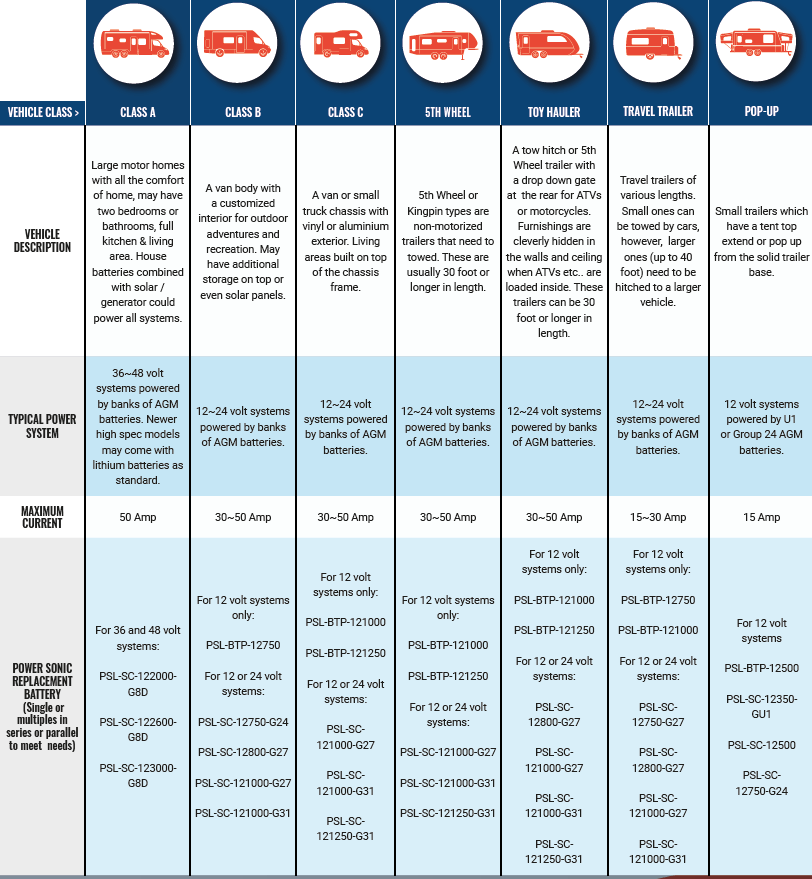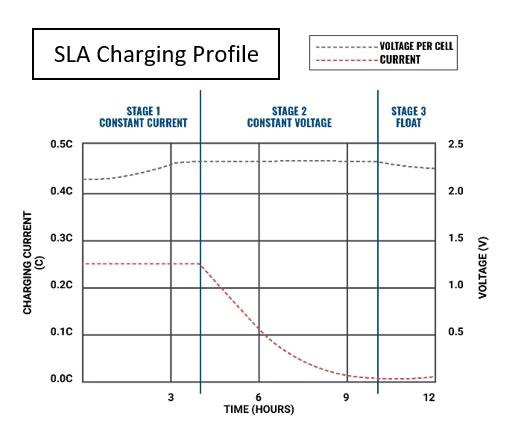If you are an RV owner, or hope to be one soon, you are well aware of the different sizes and options of recreational vehicles available on the market today. What you may be less familiar with is what the power requirements of each of those different sizes are, and why the battery charging system inside matters.
In the below chart, you will see the different classifications of RVs, their typical power systems, and the Power Sonic lithium battery we recommend for each vehicle class. Please note that these batteries are for house power only, not for starter applications (like starting a Class A, B, or C vehicle).

WHY CHOOSE A LITHIUM RV BATTERY?
Power Sonic lithium iron phosphate (LiFePO4) batteries deliver everything needed to support life on the road. Travel further and more efficiently without compromising on reliability or performance with a battery designed to perform in the most demanding conditions.
More Usable Power
Lithium batteries give you the ability to use 100% of their capacity, regardless of the discharge rate. With Lithium batteries give you the ability to use 100% of their capacity regardless of the discharge rate. With a very high discharge rate, for instance 0.8C, the capacity of a lead acid battery will only be 60% of the rated capacity. This means you can be confident when running all your electronics that, with a lithium battery there will be plenty of capacity in reserve.
Super Safe Chemistry
Power Sonic lithium batteries utilize LiFePO4 chemistry, which is the safest lithium chemistry on the market today. For increased safety, our lithium RV batteries are integrated with an advanced Protection Circuit Module (PCM) that protects against over-charge, over-discharge, over-temperature and short circuit situations.
A Longer Life with Lithium
Power Sonic RV lithium deep cycle batteries deliver up to 10 times longer cycle life than a lead acid battery. This brings down the cost per cycle of a lithium battery lower than lead acid, meaning you will replace a lithium battery less often than a lead acid battery in a recreational vehicle.
Faster Lithium Charging
Lithium battery charging can be up to 4 times faster than with lead acid. Faster charging means there is more time the battery can be in use. Another benefit is the quick and efficient energy storage from solar panels that can be integrated to your recreational vehicle.
Lithium Batteries Weigh Less
50~70% less weight than the equivalent capacity lead acid battery. For larger RV’s this could result in a weight saving of 100~200lb.
Flexible Installation
Power Sonic lithium batteries can be installed upright or on their side allowing for flexible installation and easy configuration.
Drop-In Replacement for Lead Acid
Power Sonic lithium batteries are available in a variety of BCI standard group sizes and can be used as a drop-in replacement or upgrade to lead acid.
Low Self-Discharge
A low self-discharge rate with lithium batteries means worry free storage, so even with seasonal use you can be sure your battery wont let you down. As a side note, we recommend checking OCV once every 6 month for all lithium batteries.
Maintenance Free
Plug and play design. Simple connect your battery and you are ready to go! No topping up with water, completely maintenance free.
CHARGING A LITHIUM RV BATTERY
In addition to the many different types of recreational vehicles there are also many different sources and methods used by RV’s to charge the batteries. When we talk about charging sources, this refers to how the electricity is produced. Typical sources include:
• Shore power – RV is connected to an AC outlet
• Generator – RV has a generator to provide both power and battery charging
• Solar – RV has solar array to provide both power and battery charging
• Alternator – RV drive Engine charges battery when it is running
Methods refer to how the voltage and current are controlled when charging the batteries. Methods include:
• Trickle charging at a low constant current
• Float charging at a current limited constant voltage
• Multi-stage charge systems; bulk charging at constant current, absorption charging at a constant voltage, and float charging to maintain the battery at 100% state of charge (SoC).
Within an RV there may be multiple sources for charging the battery, but typically the RV will employ a single charging method. The primary difference in the methods is the speed at which the batteries will be recharged – multi-stage charge systems are design to charge batteries as quickly as possible.
The charging settings for current and voltage only slightly differ for a sealed lead acid battery versus a lithium battery. Sealed lead acid batteries typically have charge currents that are 1/10th to 1/3rd of the rated capacity, whereas lithium batteries can be charged from 1/5th to 100% of the rated capacity – meaning a much faster charge time. The voltage settings for the absorption charge or the float charge are close enough to be ignored when switching from SLA to lithium.
TYPES OF CHARGERS TO USE
There is a lot of misinformation on the internet about the charging profiles between SLA and Lithium Iron Phosphate batteries. While RV charging systems will vary, this blog is intended to provide generalized information to the end user. As a note, one of the reasons Power Sonic chose lithium iron phosphate over other types of lithium ion chemistries is because the voltage is very similar to an SLA battery – with lithium voltage being just slightly higher at 12.8V (SLA batteries being 12V). This similarity in voltages also means the way the batteries will feature similar charging characteristics.
As you can see below, lead acid batteries and lithium batteries follow comparable charging profiles and use roughly the same voltages to charge. This means the SLA charger will charge the battery without any issues, you just will lose out on the faster charging benefit that the lithium chemistry and lithium charger will allow.


If you really want to take advantage of the lithium chemistry, we recommend upgrading the charging system to a lithium-specific charger. However, other than speed, there will be little to no impact to the lithium iron phosphate battery if it is charged with the SLA profile or charger as SLA’s charging voltage is relatively close to lithium’s charging voltage.
Additionally, lithium batteries do not need to be kept on a float charge the same way an SLA battery does – lithium batteries actually prefer not to be stored at 100% state of charge (SOC). If the lithium battery features a circuit board with protection, which our PSL-SC and PSL-BT batteries do, it will stop accepting a charge when the battery’s SOC is 100%, so the float charging from the SLA charger won’t be accepted by the battery and shouldn’t cause any degradation to the battery. It is also not advised to use a charger with a de-sulfation mode, as this will damage the lithium battery.
CHARGING A LITHIUM RV BATTERY IN SERIES OR PARALLEL
Once you’ve purchased your RV and upgraded the batteries to lithium, you may start to wonder about how those batteries will get charged. An SLA charging system will be acceptable, but what about charging while in series and parallel?
You’ll want to charge your RV lithium batteries in series and parallel (batteries in series vs parallel) the same way you would charge any other battery string, so the existing charging system in your RV should be sufficient in most cases. Lithium chargers and inverters can be installed to optimize charging performance, but the standard charging system is typically fine.
For series connections, it is important to start the batteries out at the same SOC at the time of installation– so begin with all batteries at 100% SOC. The voltage in series will vary across the string. If any battery exceeds the cell protection limits within the batteries’ BMS/PCM boards, the board will stop the charge for that battery, which will trigger protections in the other batteries and stop charging for all batteries . When charging the battery string, use a charger capable of charging the total voltage of the series connection. With lithium iron phosphate batteries, the charging voltage is 3.65V per cell or 14.6V for a 12.8V battery. You will need to multiply the charging voltage across how many batteries there are in the string to get the total charging voltage. For example, if the string equals 51.2V, the charging voltage should be 58.4V.
For parallel connections, you can charge the batteries at 1/3 C of the total rated capacity. So, if you have four 10 Amp-Hour (AH) batteries in parallel, you can charge the batteries with 14 Amps (A) – where 1/3 of 40 is 14. In the event the charging system exceeds an individual battery’s protection, the BMS/PCM board will remove the battery from the charging circuit and the rest of the batteries will continue charging.
We do recommend that you occasionally remove the batteries from the string and charge them individually to optimize battery life of the string.
Overall, you can see that the Power Sonic PSL-SC and PSL-BTP batteries are great drop-in replacements for the SLA batteries that may have come stock in your RV. In addition to the benefits of switching to lithium, you also do not need to switch over the charging system, making for a great plug-n-play option. For more information on lithium’s benefits versus SLA, visit this blog. If you should have any further questions about RV batteries and their charging systems, please reach out to us.







